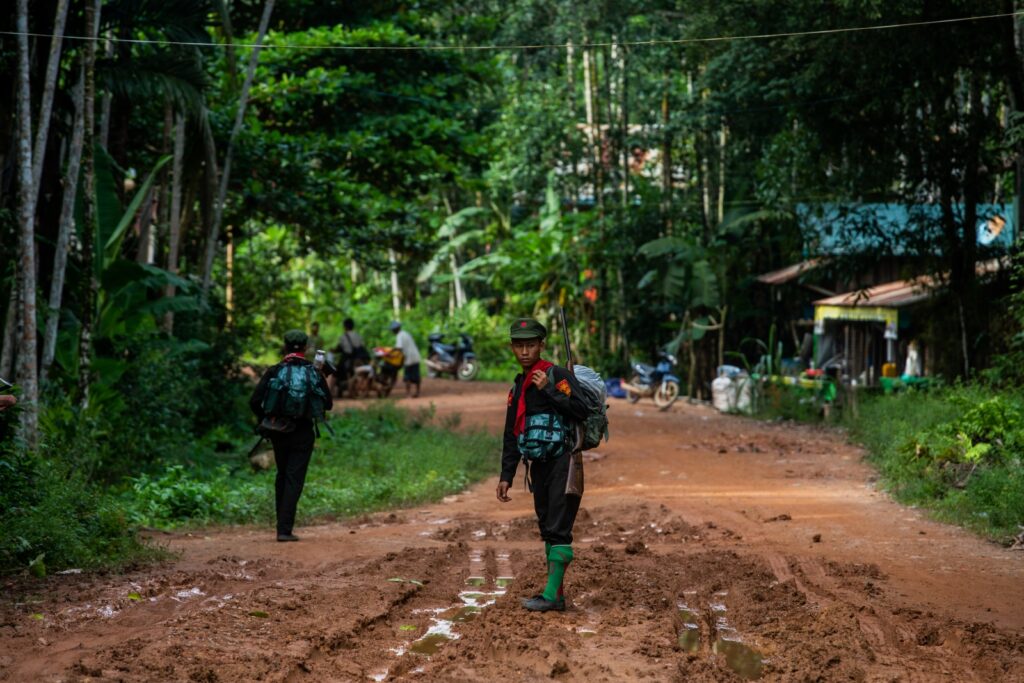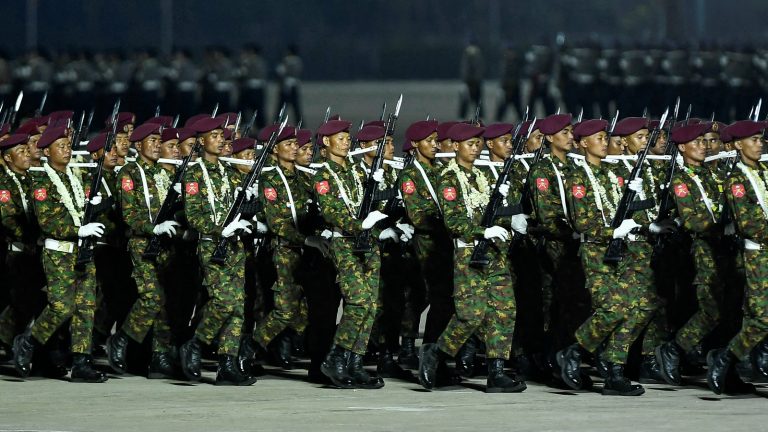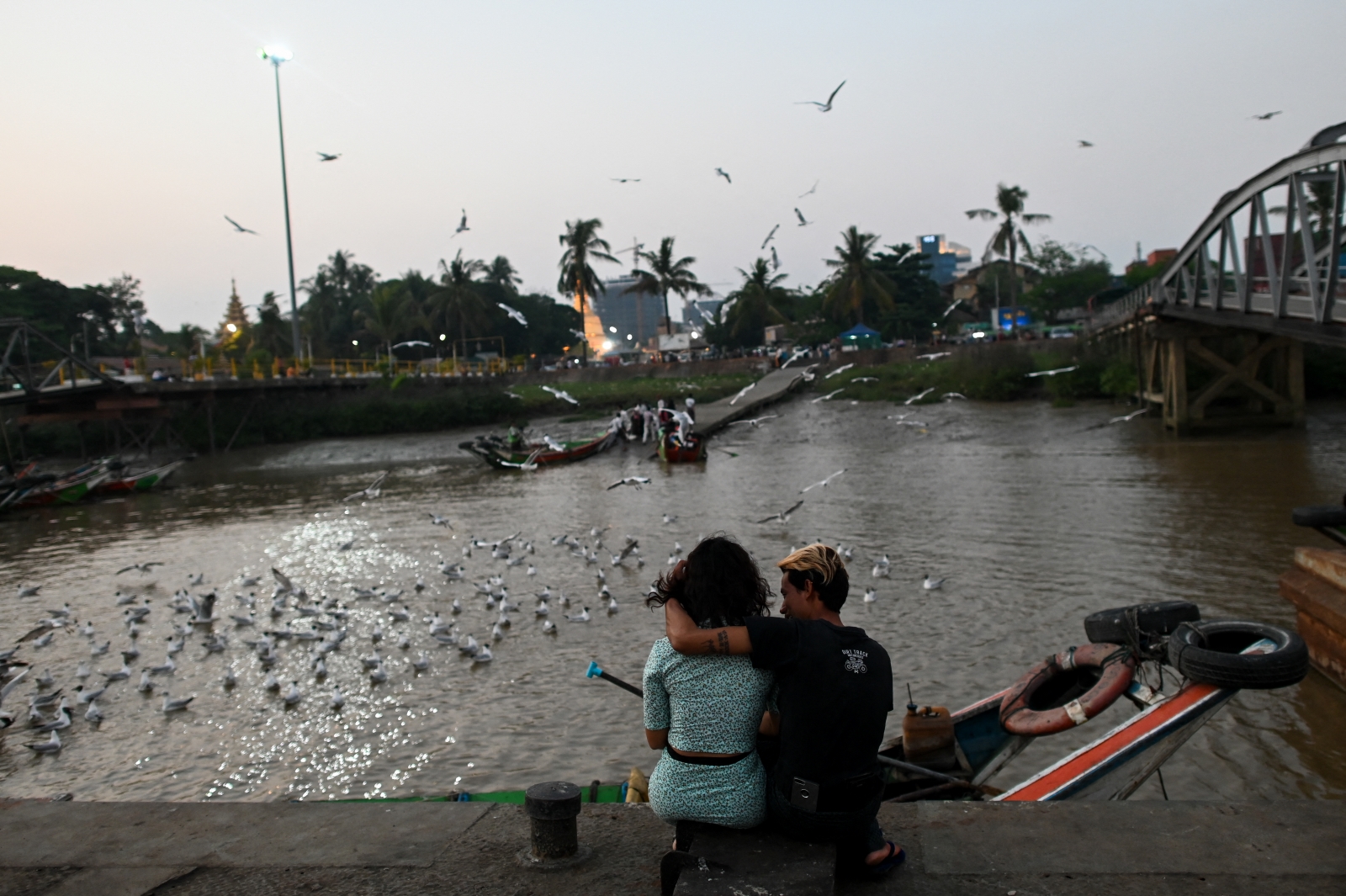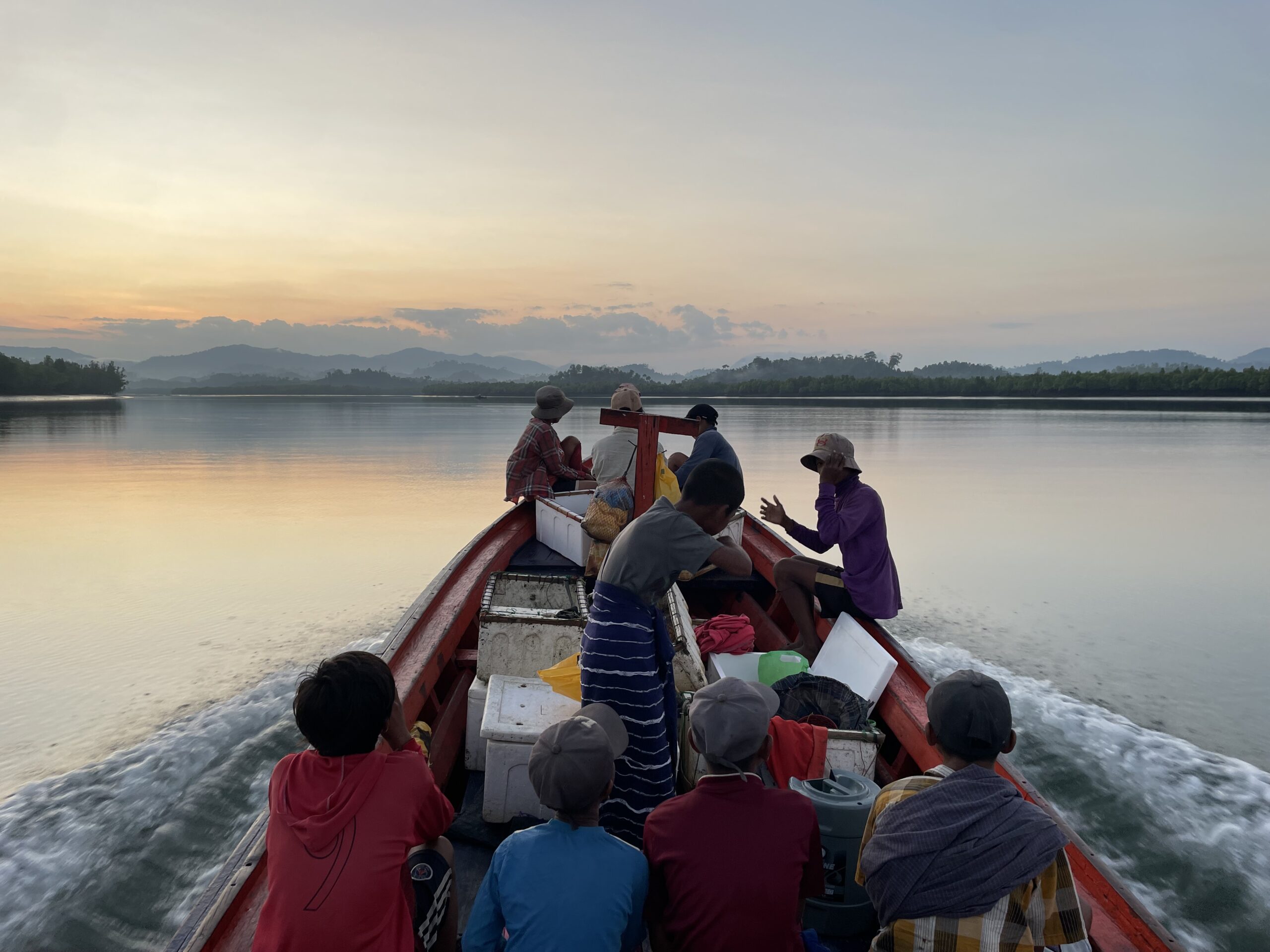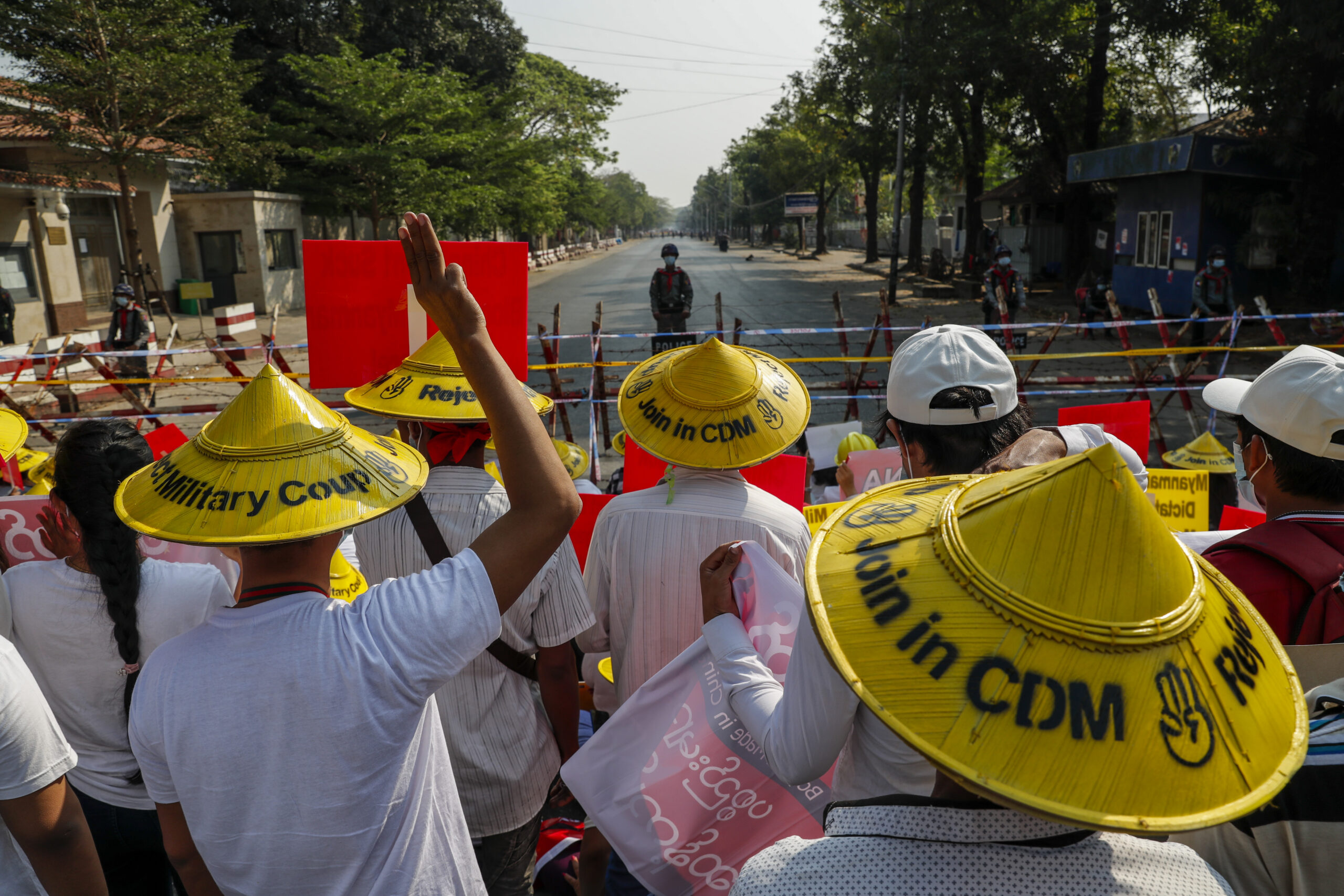Extinct for more than 30 years, the People’s Liberation Army has been resurrected – including in the country’s deep south, where the troops have focused more on building alliances and their military capabilities than spreading their ideology.
By HEIN THAR | FRONTIER
Our motorbikes struggled through the muddy, damaged road as we passed village after village outside of regime control, shaded from the fierce sun by the ubiquitous betel palms of Tanintharyi Region.
Suddenly, our convoy stopped before an unexpected, but long sought after, scene. A column of dozens of troops from the People’s Liberation Army – the armed wing of the Communist Party of Burma – were marching in formation towards a nearby village.
It was October, and we had heard for months that the PLA was becoming more active in Tanintharyi, in Myanmar’s deep south. We tried to contact them multiple times without success, but here they were right in front of us.
“It’s not every day you accidentally stumble on a group of communists,” quipped my companion, photojournalist Mar Naw.
The PLA fighters looked straight out of Central Casting in their drab dark blue uniforms, olive green cloth Mao caps with red stars, and red scarves tied around their necks.
But despite these communist hallmarks, the troops seemed to be making some efforts to obscure their politics. Patches on each arm showed a tiger’s head, symbolising Tanintharyi Region, and another red star. But more telling was the name stitched under these emblems – People’s Defence Force, or PDF.
The term PDF properly refers to anti-regime armed groups loyal to the National Unity Government – a parallel administration appointed by elected lawmakers deposed in the coup, widely seen by Myanmar society as the legitimate government. But in practice, PDF has become a catch-all for anti-junta militias in general. Moreover, while the PLA remains independent of the NUG, it seemingly doesn’t mind being associated with it.
When we reached the next village, the fighters dropped their bags at an empty house before sitting down to rest and chat with us.
“We’ve been operating here for nearly three months, but we haven’t been able to fight any battles yet. We’re still introducing ourselves to the people in the villages,” said 56-year-old U Aye*, political officer for the PLA’s Tanintharyi chapter, which according to Communist Party tradition is the highest position in the region.
He said the PLA hasn’t so far focused on spreading communism to the villagers, instead prioritising building alliances with other armed groups and getting battle-ready.
A PLA spokesperson, who asked to remain anonymous, conveyed a similar message during a telephone interview weeks later.
“We will let the military be isolated and work hand in hand with any armed group that is resisting the military,” he told Frontier. “We don’t talk about communist ideology in public campaigns; we just say that the PLA always stands with the oppressed class, that’s it.”
It’s an understandable strategy in a country where many people still grow up hearing bad things about communists.
“In our childhood, when a boy is behaving badly, the elders would always say we’re acting like a commie,” said Ko Joker, 40, spokesperson for the Tanintharyi PDF. “So I thought they were really bad guys. But now I realise that the real sinner is the Myanmar military.”
In the midst of a largely crowdfunded armed uprising, the best way to prove yourself is on the battlefield.
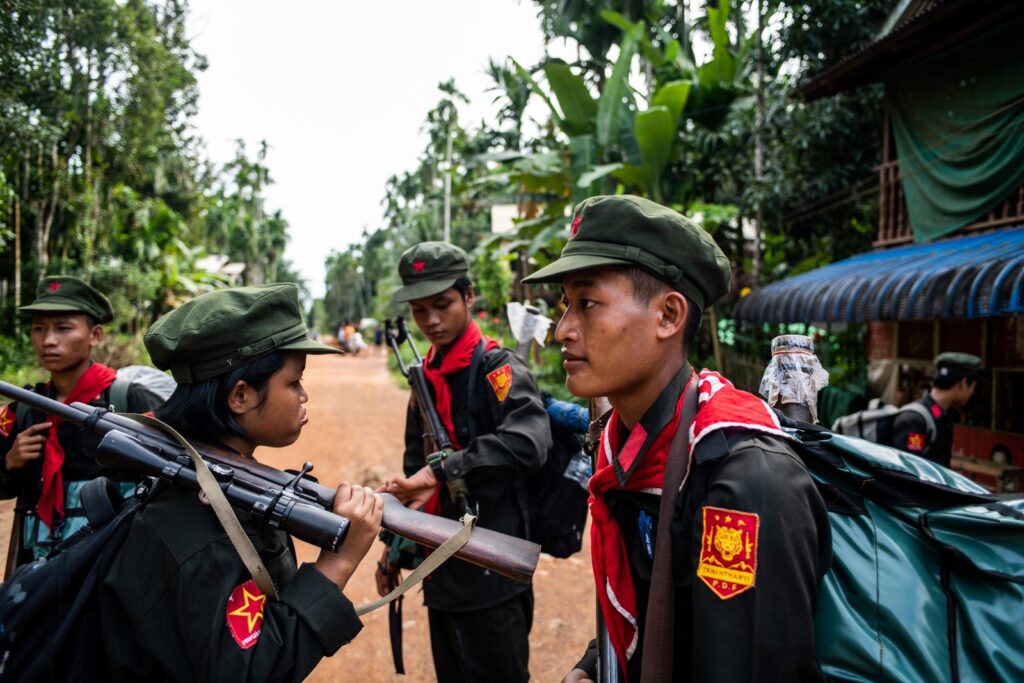
Building alliances and a reputation
This is the second time U Aye has served in the PLA. In the 1980s, when he was just 18, he joined the communist insurgency at a time when it controlled a large stretch of the Chinese border.
The CPB had carved out this territory with direct support from Beijing, but this was eventually withdrawn and the group collapsed along ethnic lines in 1989, when ethnic minority foot soldiers revolted against their Bamar officers. The split gave birth to some of Myanmar’s most powerful ethnic armed groups still operating today, like the United Wa State Army and Myanmar National Democratic Alliance Army.
But few remember that the insurgency also took root in southern Myanmar, where U Aye served. It held out in Tanintharyi for another five years, before disarming in 1994 when U Aye’s battalion of some 300 soldiers surrendered to the military. One of the most famous chairmen of the CPB, Ba Thein Tin, who served from 1975-1989, was born in the Tanintharyi capital Dawei. He helped spread leftist ideology throughout the region, where the CPB at its peak controlled a few isolated village tracts.
“This village was once part of the PLA’s territory,” said U Aye, referring to the settlement where we sat. But for now, like most of rural Tanintharyi Township, this village is controlled by the PDFs. Likewise, during our trip we stopped at many small camps controlled by the Karen National Union, which the troops said used to belong to the CPB.
Echoing other resistance groups in Tanintharyi, U Aye said getting the KNU’s Brigade 4 more deeply involved in the fighting would be a game changer for the region.
Brigade 4, which is deployed across Tanintharyi, has helped train the new generation of resistance fighters and occasionally deployed officers alongside them. However, it has remained more aloof than other brigades in Kayin State and Bago Region, where PDF units are directly embedded into the ethnic armed group. But U Aye said the PLA by itself has little chance of winning over the KNU due to ideological differences.
The Karen nationalist movement has its own divisive history with communism. A leftist faction called the Karen National United Party, based in the Ayeyarwady delta, allied with the CPB and other likeminded groups in 1959, diverging from the more right-leaning Karen faction on the Thai border. But by the 1970s, the military had largely eradicated the Karen and communist insurgencies in Ayeyarwady, leaving the more right-wing Karen leaders in charge from then on.
But other groups are more open to collaboration. In November, the PLA forged an alliance with the Kawthoolei Army and a local defence force, calling it the Southern Brothers Army. The Kawthoolei Army split off from the KNU after its leader admitted to overseeing a massacre and refused to cooperate with an investigation.
When asked about the PLA’s relationship with the NUG, U Aye avoided giving a direct answer and instead reached for his bag, pulling out a laminated QR code. He explained that the NUG had generated the code for the PLA, allowing people to send it donations via NUG Pay, an NUG-devised payment app. This suggests the parallel government is willing to lend some assistance to the group, even if this falls short of a partnership.
Political analyst U Than Soe Naing said the PLA’s rise in the last two years has been impressive and he expects the group to continue to grow in strength. “The current progressive dynamic is the result of collaboration between the older and younger generations,” he said. “They have adopted a balanced policy of making many friends while having just one enemy.”

While the PLA has been largely dormant in Tanintharyi, it’s highly active elsewhere.
The communist force was resurrected soon after the coup – on March 15, 2021 – by 32 young cadres with connections to pre-’89 CPB veterans, and these cadres received military training in Kachin Independence Army territory. Many of their early recruits were also young, educated university students, often drawn from leftist underground group the All Burma Federation of Student Unions.
The spokesperson told Frontier that in addition to Tanintharyi, the PLA is active in Kokang, Sagaing Region, Ta’ang State and Nagaland. Kokang refers to the area of northern Shan State on the Chinese border where the MNDAA operates, while Ta’ang State is the term the Ta’ang National Liberation Army uses for its somewhat scattered territories, also in northern Shan. Nagaland refers to the Naga Self-Administered Zone – a remote, sparsely populated hill tract on the border with India.
In its two-year anniversary statement, the PLA said it now has over 1,000 troops, with the spokesperson telling Frontier that the highest number are in Sagaing, which has seen some of the heaviest fighting since the coup.
In October, the MNDAA, TNLA and Arakan Army – known as the Three Brotherhood Alliance – launched a stunning offensive across northern Shan with the involvement of some PLA fighters. The Kokang-based PLA unit has been incorporated into the MNDAA’s multi-ethnic Brigade 611, made up of soldiers loaned by various post-coup armed groups.
The PLA spokesperson said the group doesn’t receive support from China or any other country. “We only receive donations from Myanmar people and support from ethnic armed groups,” he said.
But some of those ethnic armed groups, including the MNDAA and TNLA, receive support from China and China’s closest ethnic ally in Myanmar, the UWSA. So in a twist of fate, the resurrection of the PLA can be attributed partly to the ethnic armed groups that dismantled it – the UWSA and MNDAA – and to its former backer, Beijing. Unlike in the old days, however, when Bamar officers lorded over ethnic minority soldiers, it’s the ethnic armed groups taking a leading role.
The PLA has seemed keen to use Operation 1027 and subsequent fighting in other parts of the country to raise its public profile. The group posted on Facebook about its participation in fighting in northern Shan’s Hseni Township, sharing a photo of its fighters standing triumphantly in front of a seized General Administration Department office. It was also reportedly involved in the assault on Taze town in Sagaing, where resistance groups raided a police station and other government buildings before retreating.
During the 1988 uprising against military rule, with the PLA already in decline, the CPB tried to set up a new armed wing called the Democratic Patriotic Army. But the DPA failed to establish the same level of public support or battlefield prowess as today’s PLA, becoming a largely forgotten footnote in history.
In contrast, the PLA has begun publishing photographs of its troops receiving a heroes’ welcome from civilians. One such post, purportedly after a successful battle in Sagaing on November 24, showed its troops waving a red hammer-and-sickle flag as villagers lined the road to cheer. Some rushed to give them money, food and Eugenia flowers – known in Burmese as thabyay, a symbol of victory tracing back to the conquests of long-gone Myanmar kings.
* indicates the use of a pseudonym for security reasons


